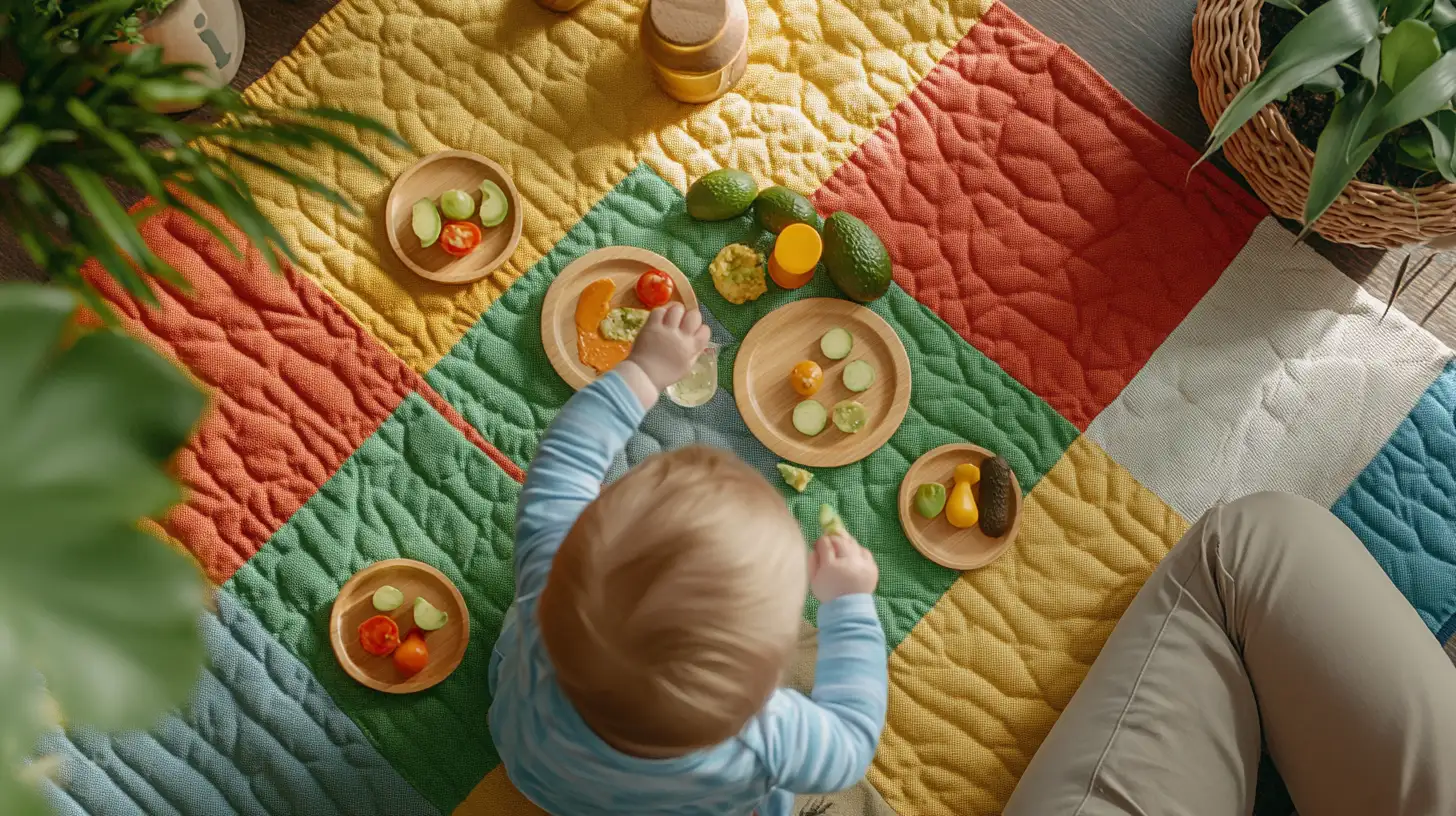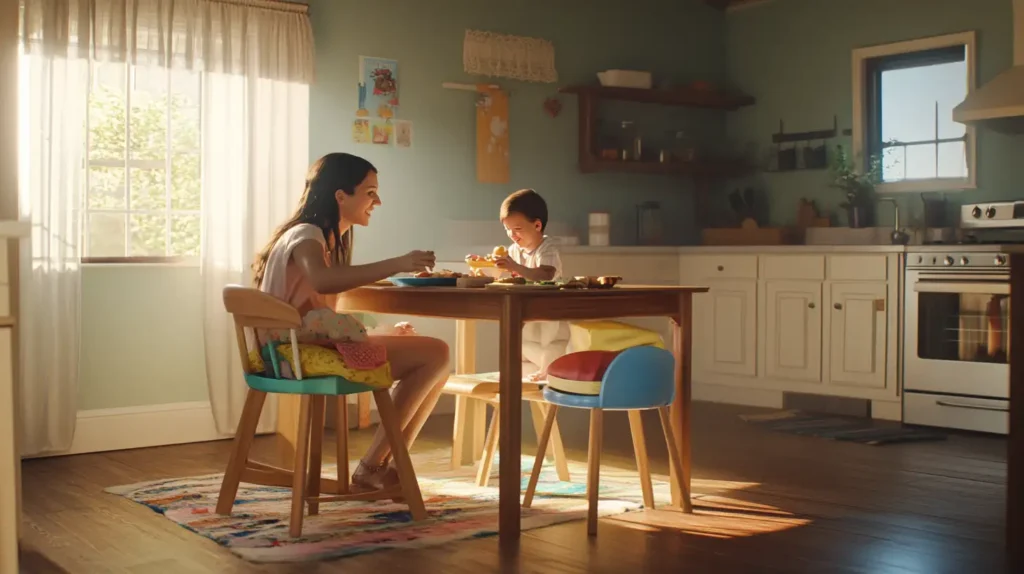Table of Contents
ToggleStop Stressing About High Chairs! 5 Flexible Feeding Solutions That Will Change Your Parenting Game
🤔 Before We Start: What’s YOUR Feeding Setup Struggle?
Choose the statement that sounds most like you:
Here’s the truth about your situation…
This may sound crazy, but the perfect feeding setup for your little one isn’t what you think. Have you ever felt overwhelmed by the massive baby gear checklist that seems to grow longer with each passing day? Maybe you’re living in a cozy apartment where every square inch matters, or perhaps you’re visiting family across town and can’t lug that giant high chair along. Whatever your situation, I’m going to share something I really wish I learned sooner as a new parent.
I shared this with my neighbor who recently became a mama and was stressing about her tiny kitchen space. She so badly wanted to create the perfect feeding environment for her baby but felt stuck between what the parenting books said she needed and the reality of her living situation. So let me explain how this works.
I used to overthink everything about feeding my first baby. Every mealtime setup, every gadget, every recommended product. And I thought if I just invested in the perfect high chair and feeding equipment, mealtimes would be smooth sailing. But in reality, that rigid thinking was just holding me back. So I made a change in my approach, and it made me more confident as a parent. I started closing that gap between what I thought I needed to do and what actually worked for our unique family.
I stopped caring about having the Instagram-perfect feeding station. I stopped caring about following every single recommendation in those parenting books. I stopped caring about what other parents at playgroup might think of my makeshift solutions. And really, this changed everything for our family mealtimes.

Why Traditional High Chairs Aren’t Always the Answer
🚨 Myth or Truth? Click Each Card to Find Out!
Here’s the biggest mistake most parents make. We think by following all the rules and buying all the essential gear, that will make things work out perfectly. The outcome of raising a healthy eater is far more important than which chair they sit in while learning to eat. I’ve seen babies who eat beautifully from a cushion on the floor, and picky eaters in $400 designer high chairs. The chair doesn’t make the eater—your responsive feeding approach does.
Don’t you feel that the opposite approach makes more sense? The more flexible and adaptable you are with mealtimes, the less stressful they become. The more you obsess over having the perfect setup, the more you might miss what’s actually working for your unique child. Babies are incredibly adaptable—they learn to eat in high chairs, bouncers, laps, even car seats when necessary. The variety actually helps them become more flexible eaters.
Traditional high chairs ARE designed with safety features, but here’s what many parents don’t realize: thousands of babies are injured in high chairs every year from falls, finger pinches, and strap-related incidents. Any feeding setup—traditional or alternative—is only as safe as the supervision accompanying it. A thoughtfully-created floor picnic with attentive supervision can be just as safe (if not safer) than a high chair where parents feel comfortable walking away.
There’s a reason why parents who embrace flexibility often have less stressful mealtimes. When you’re no longer holding on to this perfect vision, you show up differently at the table. You become calmer, you become more present, and mealtimes become more enjoyable for everyone. The baby gear industry has convinced us we need everything, but parents around the world successfully raise healthy eaters with minimal equipment.
Now, I’m not saying high chairs are bad. Traditional high chairs definitely have their place, and if you have the space and budget, they can be wonderful. But what I’m saying here is that you should try to create feeding environments that work for your specific family situation, your specific home, and your specific child’s needs.
When I visited my grandmother last summer with my toddler, I didn’t have access to any of our usual gear. You know what? We managed beautifully with some cushions on a regular chair and a towel for cleanup. My son actually ate better than he did at home! There was something about the relaxed atmosphere and lack of pressure that transformed mealtime.

The Floor Picnic: A Development Powerhouse
Now let me be clear about something that might surprise you: sometimes the best high chair alternative is no chair at all! I call this the floor picnic approach, and it’s been a game-changer for our family.
Imagine your little one sitting comfortably on a washable splat mat or outdoor blanket, food arranged nicely in front of them, enjoying the freedom of movement while they explore different foods. This approach isn’t just convenient—it’s actually developmental gold for your baby.
🎯 Quick Check: Is Floor Picnic Feeding Right For You?
How many of these apply to your baby? (Be honest!)
When my son was around 8 months old, we started incorporating floor picnics into our routine a few times a week. I noticed something amazing: his core strength improved dramatically because he was constantly adjusting his sitting position. His pincer grasp developed faster as he carefully picked up food from the blanket. And the best part? He was genuinely happy during these meals!
Here’s how to set up your floor picnic for success:
- Choose a washable mat or old beach towel as your base
- Create clear boundaries with cushions if your little one tends to crawl away
- Serve finger foods that won’t create massive messes
- Join your baby on their level for a truly communal experience
I remember my grandmother telling me how in her village, babies would often eat this way, sitting in a circle with cousins, developing not just eating skills but social bonds too. The babies learned from watching each other, and mealtimes became a community event rather than an isolated activity. The floor picnic won’t work for every meal, especially with very runny foods, but as a regular alternative in your feeding rotation, it offers benefits that no high chair can match. And the confidence your little one gains from this independence? Priceless.

Lap Sitting: When Closeness Counts More Than Equipment
Sometimes the sweetest feeding moments happen right in your lap. This isn’t just a high chair alternative—it’s an opportunity for connection that too many parents overlook in the rush to establish independent feeding.
When my daughter was going through a particularly fussy eating phase, I discovered that lap sitting during meals completely transformed her willingness to try new foods. There was something about that physical closeness that created safety for her to explore beyond her comfort zone.
Lap sitting works especially well for younger babies just starting solids, babies going through separation anxiety phases, or anytime your little one needs extra nurturing during meals. It’s also perfect for travel situations when you’re eating out or visiting homes without baby equipment.
To make lap sitting work smoothly:
- Position baby facing slightly outward so they can reach the table
- Use one arm as a gentle seat belt around their middle
- Place a napkin or small towel across both your laps
- Keep your plate slightly to the side so baby can have their own space at the table
A baby who eats in loving arms grows with a full heart, not just a full belly. There’s wisdom in these traditional approaches that modern parenting sometimes forgets in the race for the latest gear. The beauty of lap sitting is that it naturally evolves with your child’s development. What starts as a physically supportive arrangement gradually becomes more of a snuggling choice as they grow capable of sitting independently but still sometimes crave that closeness during meals.

Chair Boosters: Turn Any Chair Into Baby’s Throne
Why buy a single-purpose piece of equipment when you can transform furniture you already have? That’s the genius of the chair booster approach, and it’s been my secret weapon for creating feeding spots throughout our home.
I remember the moment this truly clicked for me. We were visiting friends for dinner, and I was stressing about how to feed my 14-month-old without a high chair. My friend simply grabbed a firm cushion, secured it with a scarf to a dining chair, wrapped a dish towel around my son’s middle as a makeshift harness, and voilà—instant feeding station that worked perfectly!
Since that eye-opening experience, I’ve created various chair boosters using common household items:
- Firm cushions or folded blankets to boost height
- Rolled towels placed in an L-shape to create corner support
- Scarves or soft fabric strips (never rope) to secure cushions
- Non-slip mats between cushions and chair to prevent sliding
Safety is paramount with this approach. Your DIY chair booster must be stable, have some form of security to keep both child and cushions in place, and you should always stay within arm’s reach. This isn’t about creating a less-safe option—it’s about thoughtfully adapting what you have.
The best part about this approach? It grows with your child. As they need less physical support, you simply reduce the boosting elements until eventually, they’re sitting directly on the chair like everyone else at the table.

Convertible Solutions: Furniture That Grows With Your Child
If you’re going to invest in any feeding equipment, make it something that serves multiple purposes and adapts as your child grows. This approach isn’t just practical—it’s financially and environmentally smart.
💰 Your Feeding Setup Savings Calculator
Let’s see how much you could save with flexible feeding solutions!
You Could Save:
By using flexible feeding solutions you already own (blankets, cushions, your lap), you’d avoid spending this entire amount! Imagine what else you could do with that money for your family.
When I was pregnant with my second child, I realized how quickly we had outgrown the expensive high chair we bought for our first. It had exactly one purpose and took up valuable space even when not in use. For our second child, I chose a completely different route: convertible, multi-use furniture.
Here are my favorite convertible feeding solutions that have been worth every penny:
- Chair systems that transform from infant recliners to toddler seats to child chairs
- Clip-on table chairs that attach to your existing furniture
- Booster seats that double as storage containers for bibs and utensils
- Floor seats that convert to table boosters as baby grows
My cousin showed me how she used a simple wooden stool with a handmade cushion that her baby used first as a supported floor seat (with adult supervision), then as a low table for floor picnics, then as a step stool to reach the family table. Three years of use from one simple piece! The key to choosing convertible options is thinking long-term. How will this item serve your family in one year? Two years? If it has multiple potential uses, it’s likely a good investment.
Finding Freedom in Flexibility
🎭 What’s Your Feeding Philosophy Type?
Take this quick quiz to discover your parenting approach!
When baby spits out a new food, you…
Your ideal mealtime looks like…
When other parents judge your feeding choices, you…
The irony is that when you embrace flexible feeding setups, things start to fall into place naturally. Your baby learns to adapt to different eating environments—a skill that will serve them well throughout life. You save money and space by not investing in single-purpose equipment. And perhaps most importantly, you free yourself from the anxiety of doing it right according to some external standard.
Imagine how you’d feel to be free from the stress of perfect mealtimes. Free from overthinking every feeding detail. Free from the fear of doing something wrong. Because here’s the thing: if your baby is safely supported, engaged with their food, and developing healthy eating patterns, you’re already succeeding—regardless of whether they’re in a designer high chair or sitting on a cushion on your kitchen floor.
If the traditional high chair works for your family, amazing! But if not, these alternatives might actually be better for your specific situation. Either way, you’re going to be okay. I promise. The best parents I know care about nutritious feeding, but they’re not attached to exactly how or where it happens. They show up, they give their best with the resources they have, and then they let go of perfectionism. Because they know if they’ve done everything they can to nourish their child both physically and emotionally during meals, they’ve already won. And so have you.
It’s time we all embrace this work with what you have energy in parenting. This feeling that you’re going to create wonderful feeding experiences regardless of your equipment or space limitations. That confidence helps you show up more present and calm at every mealtime.
Because when you stop obsessing over having the perfect high chair and instead focus on creating a loving, responsive feeding relationship with your child, that’s when true mealtime magic happens.
Whenever you’re reading this, I want you to have the courage, clarity, and the power to create feeding routines that work for YOUR family. Because you become a powerful parent when you stop caring about the wrong things—like having all the right gear—and start focusing on what truly matters: nurturing your child’s relationship with food and family meals.
If you’ve given your best with what you have, you have already succeeded as a parent. Your child doesn’t need the perfect high chair—they just need you, present and responsive, as they learn the joy of eating.
Beyond her professional achievements, Jessica is also a successful mother to a large and thriving family. Her firsthand experience in balancing financial responsibilities while raising multiple children gives her a unique perspective that resonates with her audience. As a mother, Jessica understands the financial challenges and pressures faced by families, and she brings a compassionate and relatable approach to her blogging. Through her blog, Jessica not only shares her financial expertise but also provides invaluable insights on how to foster financial well-being while building a strong and harmonious family foundation. Whether it's budgeting, saving for college, or teaching children about money, Jessica's relatable stories and practical tips make her an indispensable guide for individuals striving to achieve financial stability while nurturing a fulfilling family life.
- The Hybrid Baby Registry: Virtual and Physical Gift Management - October 19, 2025
- The Anti-Consumerist Baby Shower: Meaningful Alternative Celebrations - October 15, 2025
- Baby-Friendly Home Adaptations: No Renovation Required - September 26, 2025



